Halim Yanikomeroglu
DFT-s-OFDM with Chirp Modulation
Aug 06, 2025Abstract:In this paper, a new waveform called discrete Fourier transform spread orthogonal frequency division multiplexing with chirp modulation (DFT-s-OFDM-CM) is proposed for the next generation of wireless communications. The information bits are conveyed by not only Q-ary constellation symbols but also the starting frequency of chirp signal. It could maintain the benefits provided by the chirped discrete Fourier transform spread orthogonal frequency division multiplexing (DFT-s-OFDM), e.g., low peak-to-average power ratio (PAPR), full frequency diversity exploitation, etc. Simulation results confirm that the proposed DFT-s-OFDM-CM could achieve higher spectral efficiency while keeping the similar bit error rate (BER) to that of chirped DFT-s-OFDM. In addition, when maintaining the same spectral efficiency, the proposed DFT-s-OFDM-CM with the splitting of information bits into two streams enables the use of lower-order constellation modulation and offers greater resilience to noise, resulting in a lower BER than the chirped DFT-s-OFDM.
Data-Driven Spectrum Demand Prediction: A Spatio-Temporal Framework with Transfer Learning
Aug 05, 2025Abstract:Accurate spectrum demand prediction is crucial for informed spectrum allocation, effective regulatory planning, and fostering sustainable growth in modern wireless communication networks. It supports governmental efforts, particularly those led by the international telecommunication union (ITU), to establish fair spectrum allocation policies, improve auction mechanisms, and meet the requirements of emerging technologies such as advanced 5G, forthcoming 6G, and the internet of things (IoT). This paper presents an effective spatio-temporal prediction framework that leverages crowdsourced user-side key performance indicators (KPIs) and regulatory datasets to model and forecast spectrum demand. The proposed methodology achieves superior prediction accuracy and cross-regional generalizability by incorporating advanced feature engineering, comprehensive correlation analysis, and transfer learning techniques. Unlike traditional ITU models, which are often constrained by arbitrary inputs and unrealistic assumptions, this approach exploits granular, data-driven insights to account for spatial and temporal variations in spectrum utilization. Comparative evaluations against ITU estimates, as the benchmark, underscore our framework's capability to deliver more realistic and actionable predictions. Experimental results validate the efficacy of our methodology, highlighting its potential as a robust approach for policymakers and regulatory bodies to enhance spectrum management and planning.
Green Satellite Networks Using Segment Routing and Software-Defined Networking
Apr 29, 2025Abstract:This paper presents a comprehensive evaluation of network performance in software defined networking (SDN)-based low Earth orbit (LEO) satellite networks, focusing on the Telesat Lightspeed constellation. We propose a green traffic engineering (TE) approach leveraging segment routing IPv6 (SRv6) to enhance energy efficiency. Through simulations, we analyze the impact of SRv6, multi-protocol label switching (MPLS), IPv4, and IPv6 with open shortest path first (OSPF) on key network performance metrics, including peak and average CPU usage, memory consumption, packet delivery rate (PDR), and packet overhead under varying traffic loads. Results show that the proposed green TE approach using SRv6 achieves notable energy efficiency, maintaining lower CPU usage and high PDR compared to traditional protocols. While SRv6 and MPLS introduce slightly higher memory usage and overhead due to their advanced configurations, these trade-offs remain manageable. Our findings highlight SRv6 with green TE as a promising solution for optimizing energy efficiency in LEO satellite networks, contributing to the development of more sustainable and efficient satellite communications.
Reciprocity-Aware Convolutional Neural Networks for Map-Based Path Loss Prediction
Apr 04, 2025Abstract:Path loss modeling is a widely used technique for estimating point-to-point losses along a communications link from transmitter (Tx) to receiver (Rx). Accurate path loss predictions can optimize use of the radio frequency spectrum and minimize unwanted interference. Modern path loss modeling often leverages data-driven approaches, using machine learning to train models on drive test measurement datasets. Drive tests primarily represent downlink scenarios, where the Tx is located on a building and the Rx is located on a moving vehicle. Consequently, trained models are frequently reserved for downlink coverage estimation, lacking representation of uplink scenarios. In this paper, we demonstrate that data augmentation can be used to train a path loss model that is generalized to uplink, downlink, and backhaul scenarios, training using only downlink drive test measurements. By adding a small number of synthetic samples representing uplink scenarios to the training set, root mean squared error is reduced by >8 dB on uplink examples in the test set.
Federated Learning in NTNs: Design, Architecture and Challenges
Mar 10, 2025Abstract:Non-terrestrial networks (NTNs) are emerging as a core component of future 6G communication systems, providing global connectivity and supporting data-intensive applications. In this paper, we propose a distributed hierarchical federated learning (HFL) framework within the NTN architecture, leveraging a high altitude platform station (HAPS) constellation as intermediate distributed FL servers. Our framework integrates both low-Earth orbit (LEO) satellites and ground clients in the FL training process while utilizing geostationary orbit (GEO) and medium-Earth orbit (MEO) satellites as relays to exchange FL global models across other HAPS constellations worldwide, enabling seamless, global-scale learning. The proposed framework offers several key benefits: (i) enhanced privacy through the decentralization of the FL mechanism by leveraging the HAPS constellation, (ii) improved model accuracy and reduced training loss while balancing latency, (iii) increased scalability of FL systems through ubiquitous connectivity by utilizing MEO and GEO satellites, and (iv) the ability to use FL data, such as resource utilization metrics, to further optimize the NTN architecture from a network management perspective. A numerical study demonstrates the proposed framework's effectiveness, with improved model accuracy, reduced training loss, and efficient latency management. The article also includes a brief review of FL in NTNs and highlights key challenges and future research directions.
A Multi-layer Non-Terrestrial Networks Architecture for 6G and Beyond under Realistic Conditions and with Practical Limitations
Feb 22, 2025Abstract:In order to bolster the next generation of wireless networks, there has been a great deal of interest in non-terrestrial networks (NTN), including satellites, high altitude platform stations (HAPS), and uncrewed aerial vehicles (UAV). To unlock their full potential, these platforms can integrate advanced technologies such as reconfigurable intelligent surfaces~(RIS) and next-generation multiple access (NGMA). However, in practical applications, transceivers often suffer from radio frequency (RF) impairments, which limit system performance. In this regard, this paper explores the potential of multi-layer NTN architecture to mitigate path propagation loss and improve network performance under hardware impairment limitations. First, we present current research activities in the NTN framework, including RIS, multiple access technologies, and hardware impairments. Next, we introduce a multi-layer NTN architecture with hardware limitations. This architecture includes HAPS super-macro base stations (HAPS-SMBS), UAVs--equipped with passive or active transmissive RIS--, and NGMA techniques, like non-orthogonal multiple access (NOMA), as the multiple access techniques to serve terrestrial devices. Additionally, we present and discuss potential use cases of the proposed multi-layer architecture considering hardware impairments. The multi-layer NTN architecture combined with advanced technologies, such as RIS and NGMA, demonstrates promising results; however, the performance degradation is attributed to RF impairments. Finally, we identify future research directions, including RF impairment mitigation, UAV power management, and antenna designs.
Federated Testing (FedTest): A New Scheme to Enhance Convergence and Mitigate Adversarial Attacks in Federating Learning
Jan 19, 2025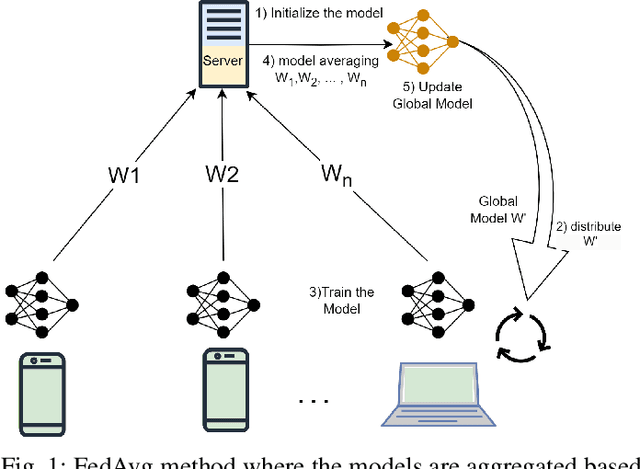
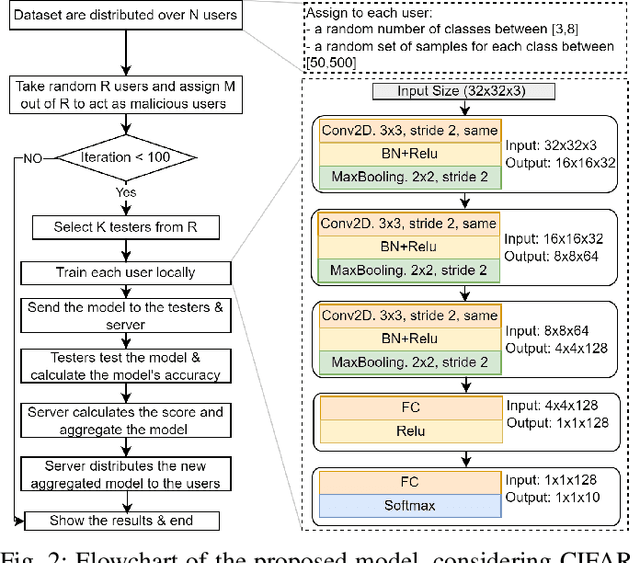
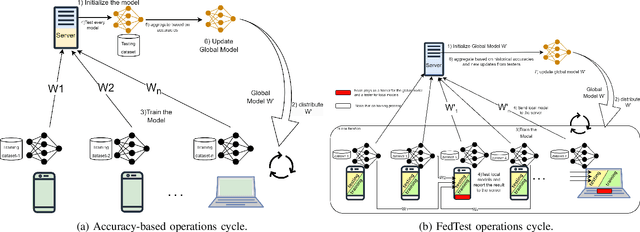
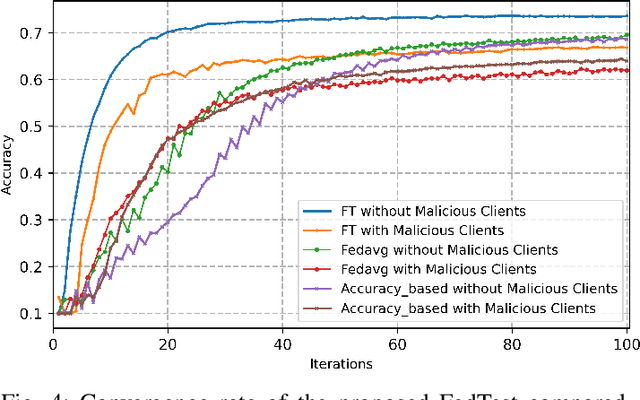
Abstract:Federated Learning (FL) has emerged as a significant paradigm for training machine learning models. This is due to its data-privacy-preserving property and its efficient exploitation of distributed computational resources. This is achieved by conducting the training process in parallel at distributed users. However, traditional FL strategies grapple with difficulties in evaluating the quality of received models, handling unbalanced models, and reducing the impact of detrimental models. To resolve these problems, we introduce a novel federated learning framework, which we call federated testing for federated learning (FedTest). In the FedTest method, the local data of a specific user is used to train the model of that user and test the models of the other users. This approach enables users to test each other's models and determine an accurate score for each. This score can then be used to aggregate the models efficiently and identify any malicious ones. Our numerical results reveal that the proposed method not only accelerates convergence rates but also diminishes the potential influence of malicious users. This significantly enhances the overall efficiency and robustness of FL systems.
Artificial Intelligence, Ambient Backscatter Communication and Non-Terrestrial Networks: A 6G Commixture
Jan 16, 2025Abstract:The advent of Non-Terrestrial Networks (NTN) represents a compelling response to the International Mobile Telecommunications 2030 (IMT-2030) framework, enabling the delivery of advanced, seamless connectivity that supports reliable, sustainable, and resilient communication systems. Nevertheless, the integration of NTN with Terrestrial Networks (TN) necessitates considerable alterations to the existing cellular infrastructure in order to address the challenges intrinsic to NTN implementation. Additionally, Ambient Backscatter Communication (AmBC), which utilizes ambient Radio Frequency (RF) signals to transmit data to the intended recipient by altering and reflecting these signals, exhibits considerable potential for the effective integration of NTN and TN. Furthermore, AmBC is constrained by its limitations regarding power, interference, and other related factors. In contrast, the application of Artificial Intelligence (AI) within wireless networks demonstrates significant potential for predictive analytics through the use of extensive datasets. AI techniques enable the real-time optimization of network parameters, mitigating interference and power limitations in AmBC. These predictive models also enhance the adaptive integration of NTN and TN, driving significant improvements in network reliability and Energy Efficiency (EE). In this paper, we present a comprehensive examination of how the commixture of AI, AmBC, and NTN can facilitate the integration of NTN and TN. We also provide a thorough analysis indicating a marked enhancement in EE predicated on this triadic relationship.
Investigating Map-Based Path Loss Models: A Study of Feature Representations in Convolutional Neural Networks
Jan 13, 2025
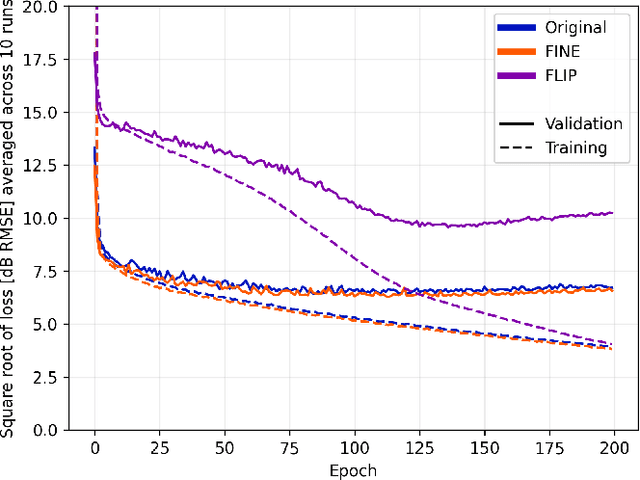

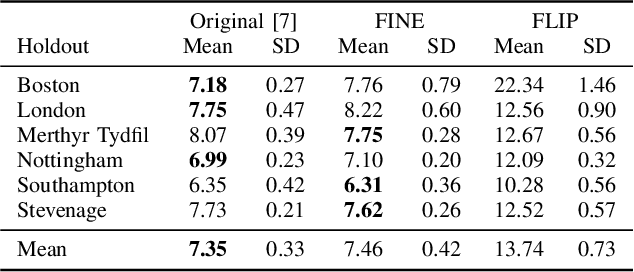
Abstract:Path loss prediction is a beneficial tool for efficient use of the radio frequency spectrum. Building on prior research on high-resolution map-based path loss models, this paper studies convolutional neural network input representations in more detail. We investigate different methods of representing scalar features in convolutional neural networks. Specifically, we compare using frequency and distance as input channels to convolutional layers or as scalar inputs to regression layers. We assess model performance using three different feature configurations and find that representing scalar features as image channels results in the strongest generalization.
Path Loss Prediction Using Deep Learning
Nov 25, 2024



Abstract:Radio deployments and spectrum planning can benefit from path loss predictions. Obstructions along a communications link are often considered implicitly or through derived metrics such as representative clutter height or total obstruction depth. In this paper, we propose a path-specific path loss prediction method that uses convolutional neural networks to automatically perform feature extraction from high-resolution obstruction height maps. Our methods result in low prediction error in a variety of environments without requiring derived obstruction metrics.
 Add to Chrome
Add to Chrome Add to Firefox
Add to Firefox Add to Edge
Add to Edge